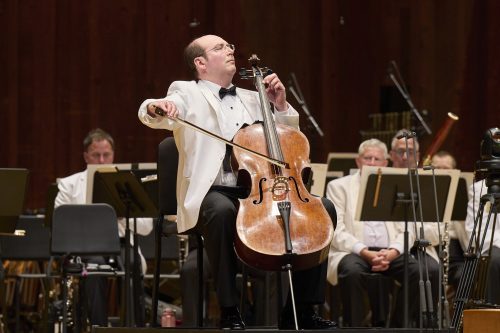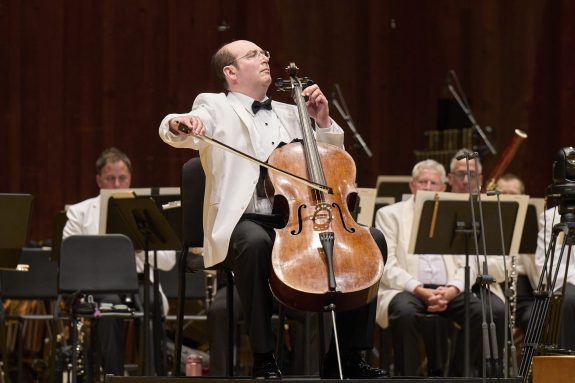 United States Blossom Festival 2024 [4]: Mark Kosower (cello), Cleveland Orchestra / Hannu Lintu (conductor). Blossom Music Center, Cuyahoga Falls, 27.7.2024. (MSJ)
United States Blossom Festival 2024 [4]: Mark Kosower (cello), Cleveland Orchestra / Hannu Lintu (conductor). Blossom Music Center, Cuyahoga Falls, 27.7.2024. (MSJ)

Sibelius – ‘Lemminkäinen’s Return’ from Four Legends of the Kalevala, Op.22
Walton – Cello Concerto
Shostakovich – Symphony No.5 in D minor, Op.47
Pre-concert feature: Kent/Blossom Chamber Orchestra / Daniel Reith (conductor)
Beethoven – Symphony No.2 in D major, Op.36
It is not easy to steal the show from a heavy-hitter like Shostakovich’s Fifth, especially with a mostly introspective and dreamy piece. But kudos to the Cleveland Orchestra’s principal cellist, Mark Kosower, for doing so. Much less often heard than the Shostakovich, the cello concerto by English composer Sir William Walton is nonetheless an intoxicating swirl of kaleidoscopic colors and moody longings, harking back to the ambivalence of the same composer’s early Viola Concerto, but with a greater sense of color and sensuality.
Kosower leaned into the personal feel of the solo part, making it sing and sigh under the flecks of color in Walton’s orchestration, delivered with a sure hand by guest conductor Hannu Lintu. They joined together for sparks and mischief in the virtuosic Allegro appassionato second movement, the most extroverted part of the work. Then, as the finale began, one of those magical moments happened that can only occur at an outdoor festival. Somewhere deep in the woods on the north side of the pavilion, a dove began singing. Its falling call fitted in with the sweetly melancholy cello part like it was meant to be. Kosower was so deep inside the music, he was unfazed, passing into the ardent cadenza which follows with a feeling of inevitability. When the piece ended, using the standard version of the work, not the loud alternate ending, it trailed off into a breathtaking silence that remained unbroken for many seconds.
Kosower is always a compelling soloist, but this performance was a deft mixture of moody brilliance and lyrical longing, and so compelling that it will stand in memory for a long time. The cellist seemed surprised by the impact he had. He attempted at one point during the ovation to get his colleagues in the orchestra to stand and join him in accepting the applause, but they refused to do so, acknowledging that the moment was for him alone. Then he seemed even more surprised when Lintu pushed him back to center stage to do an encore in response to the extended applause. It is not often that a quiet and dreamy piece draws an encore, but it did here, and Kosower responded with a thoughtfully elegant performance of a movement from one of Bach’s solo suites.
The concert was started with alacrity by Lintu striding on stage with complete confidence and launching into a crisp and compelling performance of ‘Lemminkäinen’s Return’ from the Four Legends of the Kalevala suite. Accents and syncopations were delivered with what can only be described as mastery. It makes one long to hear Lintu in the complete Legends, which hasn’t been done in full for quite a while in Cleveland. The conductor’s confident swagger pushed forward in places, released tension in others, and brought it to a roaring close.
I wish the conductor had brought the same swaggering certainty to Shostakovich’s Symphony No.5, but the performance was a little on the subdued and dour side though still powerful. Lintu’s control tended to shape the piece in long stretches of one continuous tempo, whereas the composer’s score suggests a lot more ebb and flow. The least effective stretch was the first half of the finale. Like all too many conductors, Lintu started it at a moderate speed, quickly shifted to a fairly fast tempo, and then kept that until the big implosion in the middle of the movement. That is not what Shostakovich asked for, though. What he actually wrote was for that first tempo adjustment to increase the speed some, but not a lot. Then, each succeeding paragraph of the music is designated to speed up another notch, a stairstep effect through ever-increasing tempos, resulting in a hysterically fast dash by the middle of the movement which fuels the implosion. Without that motivation, what exactly is the point of said implosion?
Lintu’s approach seemed an attempt to minimize the political and biographical details that swarm around the work, giving it a firm, classical shape. Even his delivery of the infamous closing pages was restrained. The program note by commentator Peter Laki was in the same spirit, disingenuously describing the closing pages as the moment the melody ‘suddenly alights on a bright D major chord in full orchestral splendor – remaining unchanged for more than a minute to end the symphony’.
I am sorry, but this ending is not really that ambivalent, especially considering that we now know that the movement’s theme quotes a song Shostakovich had written, but kept hidden, which talks about how barbarians suppress the works of artists. It is an obvious reference to Soviet premier Josef Stalin denouncing Shostakovich and nearly ending his career. Shostakovich carefully wrote his Fifth to placate the authorities by pulling back from the experimental edge of his previous works, but he made sure to bury things in the music that tell the true story. I am not saying Shostakovich was some heroic dissident, for he compromised himself many times by taking awards and commissions from the Soviets. But it is evidently true that he buried subversive meanings in many of his works and ignoring them or pretending they don’t exist does the works no justice. And in an age where many powerful forces try to steamroll over anything they do not want to hear, isn’t it important to sear them with the truth?
I don’t mean this to sound like a pan of Lintu’s performance as he is a highly skilled and assured conductor. His Sibelius proved that he can set music on fire if he so desires. That is why his grim approach to the Shostakovich was a little disappointing, when it can certainly handle the same flame. The performance was solid but in no way approached the searing scorch of Jakub Hrůsa’s interpretation with the orchestra in 2018, review here.
The Cleveland Orchestra was in fine form throughout and was joined in the Shostakovich by members of the Kent/Blossom Chamber Orchestra, an orchestral training and mentorship program that runs in the summers, giving music students an opportunity to work with members of the Cleveland Orchestra. Since its founding, the program has worked with over 2500 young musicians, sixteen of whom have gone on to join the Cleveland Orchestra. In the Shostakovich, there is a lot to be said for having seven horns and five flutes, for it deepened and enriched the orchestral palette. Before the main event, a pre-concert by the KBCO delivered an alert performance of Beethoven’s Symphony No.2, conducted with good attention to detail by Cleveland Orchestra associate conductor Daniel Reith.
Mark Sebastian Jordan
